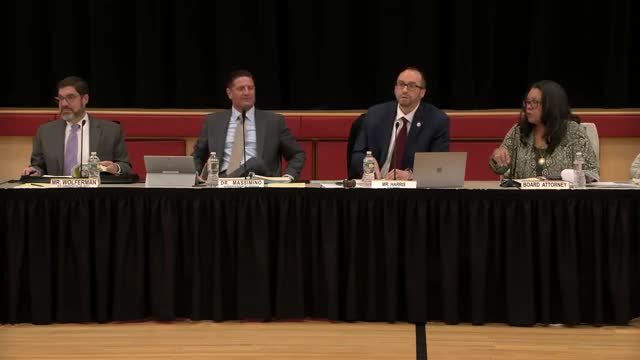Wilbur Central rolls out metal detectors at high schools; board and public discuss expansion and logistics
April 20, 2025 | Woodbridge Township School District, School Districts, New Jersey
This article was created by AI summarizing key points discussed. AI makes mistakes, so for full details and context, please refer to the video of the full meeting. Please report any errors so we can fix them. Report an error »

The Wilbur Central Board of Education on April 17 confirmed the district has deployed metal detectors at its three high schools and said officials are working through operational issues before considering expansion to other grade levels.
Board President Mr. Harris opened the discussion after public comment and committee votes and the board described the device rollout as a rapid response following a recent incident. "When the incident happened on 1 day, the next day, the metal detectors were ordered," the superintendent said.
Why it matters: Board members and speakers framed the detectors as a safety measure taken quickly after a specific event; parents and residents urged the district to consider adding detectors at middle and elementary schools and to identify funding and staffing options before wider rollout.
Superintendent Dr. Massimino told the board the district has learned practical lessons during the first week of operation and is in contact with neighboring districts that have implemented similar systems. "We're starting our three high schools. Expansion is obviously something that we will have conversation about," he said, adding that the district is balancing economic and personnel impacts tied to collective-bargaining agreements.
Public comments at the meeting pressed the board to expand the devices. "What I would recommend is would be to put detectors all the schools," said one resident identified in the transcript as Mr. Vittar. Another speaker urged the district to consider corporate or private donations to offset costs and suggested dedicating detectors in memory of community members.
Board members and administrators described operational challenges and early fixes: adjustments for arrival times, bag screening, staff deployment and parent communications. The superintendent said stakeholders including parents, teachers and students have been largely cooperative. "I don't know what the cost for keeping children safe is... I don't know what the time frame is or how much it's worth. To me, they're both immeasurable," he said.
The district noted constraints that will shape any expansion decision: delivery lead times for equipment, budgetary limits, personnel needs and collective-bargaining parameters for staff who would operate checkpoints. The board said it will first continue to stabilize operations at the three high schools and then evaluate expansion options, including cost estimates and scheduling impacts.
Board action connected to safety: the Safety and Security Committee presented one item that the board adopted by roll call (recorded as approved). Separately, several speakers thanked staff and volunteers for assisting with the rollout and for improving efficiency at entry points.
What’s next: The board said it will continue collecting data from the current implementation, consult with nearby districts, and return to the question of wider deployment once logistics, staffing and funding scenarios are clearer.
Ending: Administrators encouraged community members to raise questions through school channels while the district completes the initial rollout and evaluation.
Board President Mr. Harris opened the discussion after public comment and committee votes and the board described the device rollout as a rapid response following a recent incident. "When the incident happened on 1 day, the next day, the metal detectors were ordered," the superintendent said.
Why it matters: Board members and speakers framed the detectors as a safety measure taken quickly after a specific event; parents and residents urged the district to consider adding detectors at middle and elementary schools and to identify funding and staffing options before wider rollout.
Superintendent Dr. Massimino told the board the district has learned practical lessons during the first week of operation and is in contact with neighboring districts that have implemented similar systems. "We're starting our three high schools. Expansion is obviously something that we will have conversation about," he said, adding that the district is balancing economic and personnel impacts tied to collective-bargaining agreements.
Public comments at the meeting pressed the board to expand the devices. "What I would recommend is would be to put detectors all the schools," said one resident identified in the transcript as Mr. Vittar. Another speaker urged the district to consider corporate or private donations to offset costs and suggested dedicating detectors in memory of community members.
Board members and administrators described operational challenges and early fixes: adjustments for arrival times, bag screening, staff deployment and parent communications. The superintendent said stakeholders including parents, teachers and students have been largely cooperative. "I don't know what the cost for keeping children safe is... I don't know what the time frame is or how much it's worth. To me, they're both immeasurable," he said.
The district noted constraints that will shape any expansion decision: delivery lead times for equipment, budgetary limits, personnel needs and collective-bargaining parameters for staff who would operate checkpoints. The board said it will first continue to stabilize operations at the three high schools and then evaluate expansion options, including cost estimates and scheduling impacts.
Board action connected to safety: the Safety and Security Committee presented one item that the board adopted by roll call (recorded as approved). Separately, several speakers thanked staff and volunteers for assisting with the rollout and for improving efficiency at entry points.
What’s next: The board said it will continue collecting data from the current implementation, consult with nearby districts, and return to the question of wider deployment once logistics, staffing and funding scenarios are clearer.
Ending: Administrators encouraged community members to raise questions through school channels while the district completes the initial rollout and evaluation.
View full meeting
This article is based on a recent meeting—watch the full video and explore the complete transcript for deeper insights into the discussion.
View full meeting
